Emperor: Battle for Dune Updated Preview
Westwood dropped by our offices with the latest build of this 3D RTS in hand.
Ever since the release of early real-time strategy games like Dune II, Warcraft, and Command & Conquer, the recipe for making a successful real-time strategy game has largely remained unchanged. Of course, there have been minor alterations like the addition of more than two factions as well as small changes in basic play mechanics. The transition into full three-dimensional worlds has caused some developers to experiment with the genre a little more, but most choose not to stray too far from the typical real-time strategy path. Often credited for creating the basic real-time strategy formula, Westwood Studios is taking a similar approach with its latest real-time strategy game, Emperor: Battle for Dune by bringing the series into a three-dimensional world while at the same time designing the gameplay in such a manner that both real-time strategy veterans and novices can jump right into the action. Despite its foray into the third dimension, Emperor: Battle for Dune will seem instantly accessible to anyone who's played Westwood's RTS games in the past. We recently had a chance to take a look at the latest build of the game and spent a few hours fiddling with its campaign and skirmish modes. While it still feels like a classic Westwood real-time strategy game, Battle for Dune brings more than a few innovations to the genre.
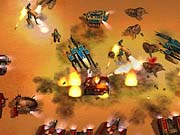
A perfect example of this innovation is the skirmish mode, which plays like just about every other RTS game's skirmish mode, but it offers some new twists in planning out your strategy. First, you select from one of the three houses available in Battle for Dune--Atreides, Harkonnen, and the new house known as Ordos. Each house has its own strengths and weaknesses, so your strategy should focus on whatever those abilities are. For example, the units found in the house of Ordos have a strong initial defense, but if an enemy breaks through that defense, then the Ordos become incredibly vulnerable to other enemy attacks. Conversely, if you designate the Ordos as the computer-controlled opponent, then you have to be aware of its speed and defense capabilities in order to plan an effective attack or to successfully defend your base. Once you decide which house you wish to control and which houses the computer will control, you can then decide if you want to form alliances with any of the secondary groups found within the Dune universe. You can select from Ixian, Tleilaxu, Fremen, Imperial, and Guild subhouses--again, these subhouses have advantages and disadvantages when aligned with any of the three houses. You'll find that some subhouses complement the abilities of certain houses better than others, and experimenting with different combinations of house-subhouse alliances is highly recommended.
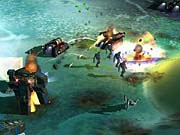
There are also the traditional set of options that you can adjust before the game starts such as the default amount of money and the number of units each house starts with. You can also toggle the fog of war, item crates, and the massive worms of Dune, which play an incredibly important role in the game as both a great equalizer and a destructive weapon.
Going through the process of selecting houses and alliances is a chore in and of itself, but it can pay off in the end when you gather your forces and move into enemy territory to do battle over the most precious commodity in the Dune universe: the spice. But before that happens, it's a good idea to familiarize yourself with the units themselves. We spent most of our time with House Harkonnen, so we've compiled a complete list of all the units you'll find in that faction.
Harkonnen Units
The House Harkonnen units are built for brute force, and while they might lack the graceful design of the House Attreides units, they are extremely effective at what they do: destroy. Harkonnen units are heavily armored, can withstand the harshest of environments, and will continue to function at full capacity until they are completely destroyed.
Mobile construction vehicle: A staple of Westwood real-time strategy games, the MCV in Battle for Dune remains largely unchanged from those of the Command & Conquer series. When deployed, the MCV drills partway into the ground and extracts the material it needs to transform itself into the construction yard. From this building, you'll have access to other structures and units.
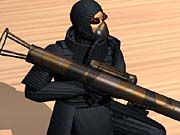
Harvester: Another pillar of Westwood RTS games is the harvester. One is automatically built with every refinery you construct, and it moves out onto the sand to collect spice.
Scout: Scouts are fast-moving soldiers that have a far line-of-sight rating, which lets them reveal more of the map than typical infantry. Because they're not well equipped for combat, scouts ensure their survival by blending in with the background when stationary.
Light infantry: As their name implies, light infantry are fast and mobile, although not very well armored. They carry a standard machine gun that is effective against other infantry but useless against vehicles unless they vastly outnumber it.
Trooper: Troopers are more powerful than light infantry, but they're significantly slower. They carry a large missile launcher and are protected by a moderate plate of armor. Their missiles have limited tracking capability, so they are somewhat effective against airborne targets. Their primary purpose, however, is for use against land-based vehicles.
Flamethrower infantry: These are the slowest of all the Harkonnen infantry, but they're also the most devastating. This unit carries a tank of fuel on its back and sprays nearby enemies with a stream of white-hot fire that's particularly effective against other soldiers.
Engineer: Like those of other Westwood games, engineers in Battle for Dune can capture enemy buildings by simply entering them. The engineer can also be sent into a friendly building in order to repair it, and for the first time in a unique twist to Westwood's RTS formula, the engineer also carries a small pistol for self-defense.
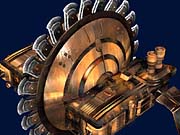
Buzzsaw: The buzzsaw is the fastest land vehicle in the Harkonnen arsenal, and it makes use of two very powerful weapons. The first is actually a pair of light cannons that are somewhat effective against other vehicles. The buzzsaw's primary weapon, however, is its center-mounted large blade that can tear up spice fields and infantry alike with ease.
Assault tank: The assault tank acts as the Harkonnen's iron fist. It is slow but extremely powerful: Its medium-range cannon can knock down buildings and enemy vehicles with ease, and its thick armor makes it nearly impervious to enemy fire. Its main drawback, however, is its fixed turret, which means that the assault tank will have a hard time engaging fast-moving units.
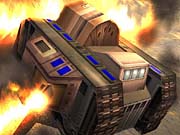
Flame tank: While flame tanks are even slower than assault tanks, they benefit from having mobile turrets, two of them, in fact. Each of this tank's side-mounted flamethrowers can track ground enemies separately, making it extremely effective against a crowd of soldiers. Likewise, it can also focus its flamethrowers on one target for a devastating blow.
Missile tank: Like most artillery, the missile tank is lightly armored, but it benefits from the ability to fire at long distances. The missile tank can fire a salvo of eightrockets at once, but it takes a long time for it to reload. Despite its light weight, the missile tank isn't very fast.
Inkvine catapult: This unique unit lobs barrels of toxic fluid called inkvine in an arc similar to the missile tank's rockets. When these barrels impact the ground, they release their poisonous fluid that gradually damages any infantry within their area of effect. Any soldiers who wander onto the infected ground will also sustain damage until all the toxic fluid dissipates.
Devastator: The devastator is the Harkonnen's heaviest tank. It carries two plasma cannons that can destroy most smaller vehicles and severely weaken shields with a single blow. It also has a battery of guided ground-to-air missiles for use against airborne vehicles. Additionally, should the need arise, you can make the devastator self-destruct by overloading its nuclear reactors--the resulting explosion will kill anyone in the vicinity.
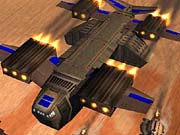
Carryall: The carryall lifts harvesters to and from spice fields. This not only speeds up harvesting, it also lessens the chance of a worm attack, since harvesters aren't forced to trudge across the sand. The carryall doesn't require any input from you--it does its job automatically.
Ornithopter: The ornithopter is a slow-moving VTOL craft that fires unguided air-to-ground rockets. The ornithopter is effective against isolated units, and it needs to return to a helipad in order to reload.
Air defense platform: The ADP is a slow-moving unit whose primary role is for base defense. Its rotating cannon can target both air and ground vehicles.
Advanced carryall: Unlike the standard carryall, the advanced carryall can ferry any unit to and from anywhere on the map at your command. Its heavy armor lets it take more punishment than the standard carryall, but it lacks any offensive weapons of its own.
3D Looks, 2D Feel
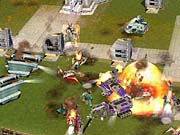
As previously noted, Westwood Studios deliberately wants to make Emperor: Battle for Dune much more like a classic real-time strategy game rather than a game where it takes too much time for people to become familiar with the mechanics, and, as such, the addition of the third dimension and floating camera doesn't play much more than an aesthetic role. When you finally get into the skirmish match, the camera positions itself in a familiar view situated nearly directly above your base, but since the game is now in full 3D, you can rotate the camera around an axis point using your mouse, and you can just easily zoom in and out with a wheel-equipped mouse. Obviously, there isn't much of a tactical advantage if you zoom in on your base or individual units because your range of vision is seriously restricted, and you can't see approaching enemy units. Though, getting a closer look at your base and units gives you a much greater appreciation for the amount of detail Westwood is putting into structures and individual units. When the camera is zoomed out from the default position, you have a much better view of the surrounding area and a better chance of detecting any enemy units and Dune worms if they're approaching your base or your units. In the current build of the game, zooming the camera is especially helpful for selecting and grouping a larger set of units and placing them in strategic areas around the base before you send them off to fight largely because the waypoint system is not quite functional yet.
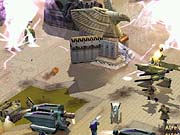
Finding a comfortable camera view probably takes up the most time, but since the rest of Battle for Dune's interface remains largely unchanged from previous Westwood real-time strategy games, you can start building up your arsenal and defenses in no time. On the top right of the screen is the basic radar where you get a general view of the area and more is revealed as your units begin to leave the base and explore the area. The amount of money--or Solaris as it's called in the game--is also located at the top of the screen. Below that, information on power usage is also visible and can help inform you when additional power resources are needed to construct more buildings. There's also a button for retreats where you can select a group of troops and tell them to retreat thus adding them to your reserves that can be used later in battle. In addition, there is a familiar set of buttons that let you repair units, sell structures, or tell units to guard an area. Just to the left of the main buttons are three icons that denote structures, troops, and vehicles, which all give information on the units and structures currently available. If you want to know which troops you can train, simply click on the troop icon and the list of current troops available displays in the right column--the same goes for structures and vehicles. The left icon menu can occasionally cause some problems during the heat of battle if you're trying to move a set of units in an area covered by that portion of the interface because you can accidentally click the icon rather than the portion of the map you want to move your troops to.
Final Thoughts
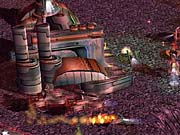
Unit movement really hasn't changed all that much since Dune II, and Emperor: Battle for Dune isn't an exception though it does bear some cosmetic resemblance to Westwood's Red Alert 2. Essentially, you can select units by dragging the mouse around a group and releasing the button, and you have the added ability to group them according to number so that you can move that group instantly. Actual movement is controlled with a simple left-mouse button click, and when pressed, the path of your units displays on the screen in similar fashion to that of Red Alert 2. Some structures, like the construction yard, can also move around the map by clicking on them and telling them where to go. This is especially helpful if you're coming under enemy fire or if your spice supply is threatened by enemy units, but you shouldn't move structures around too often because of one of Dune's most unpredictable inhabitants, the gigantic sand worms.
There are three different types of sand worms in Battle for Dune, and all of them pose a serious threat to your units when moving from solid rock over the vast sand dunes of the planet Arrakis. While in the back of your mind, you may know that the vibrations of troops moving over the sand causes the worms to stir, it's still incredibly difficult to predict the appearance of a sand worm. You may move your troops out into the sand thinking it's perfectly safe only to see lightning and hear the terrifying sound made by the worms. When troops and vehicles are too far away from the solid areas, all you can do is watch these massive creatures devastate your army. One impressive moment in Battle for Dune occurs when the largest of the three sand worms emerges from the sands casting a massive shadow over the landscape while it swallows all units in the immediate area and then drops back down into the dunes.
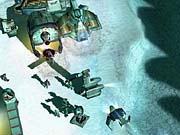
While they have tremendous destructive power, you can actually use the worms to service your own army. A particular advantage of allying the Fremen group with one of three houses is that they have the ability to summon one of the smaller worms and control it. During our skirmish match, the computer-controlled Harkonnen sends over a group of vehicles capable of doing massive damage to the base, but before any of them actually reach the base, one of the Fremen units manages to summon a worm at just the right moment, causing massive damage to the Harkonnen units and possibly saving our base from complete annihilation. Unfortunately, you can only summon the worms for a short period of time, and in some maps summoning a worm can often be futile because it not only takes a substantial amount of time to summon one, but it can also be difficult to navigate the worm between the rocky areas. Nonetheless, the worm can help tremendously, especially during battles where the enemy forces outnumber your own.
In addition to worm-riding, Emperor: Battle for Dune includes a number of other interesting features. The campaign mode offers tremendous amounts of variation letting you plan a strategic attack against the two other houses, while at the same time, they coordinate their attacks against your house. The campaign mode also takes you to different planets and during one mission you must actually fight enemies while traveling through a massive ship. Additionally, the campaign mode supports cooperative multiplayer, so you and one other player can work toward successfully completing individual missions. Without question, Emperor: Battle for Dune follows the traditional real-time strategy formula, but there are enough new features and additions to the gameplay to entertain just about any strategy fan. The game is currently scheduled for a June 12 release.
Got a news tip or want to contact us directly? Email news@gamespot.com
Join the conversation